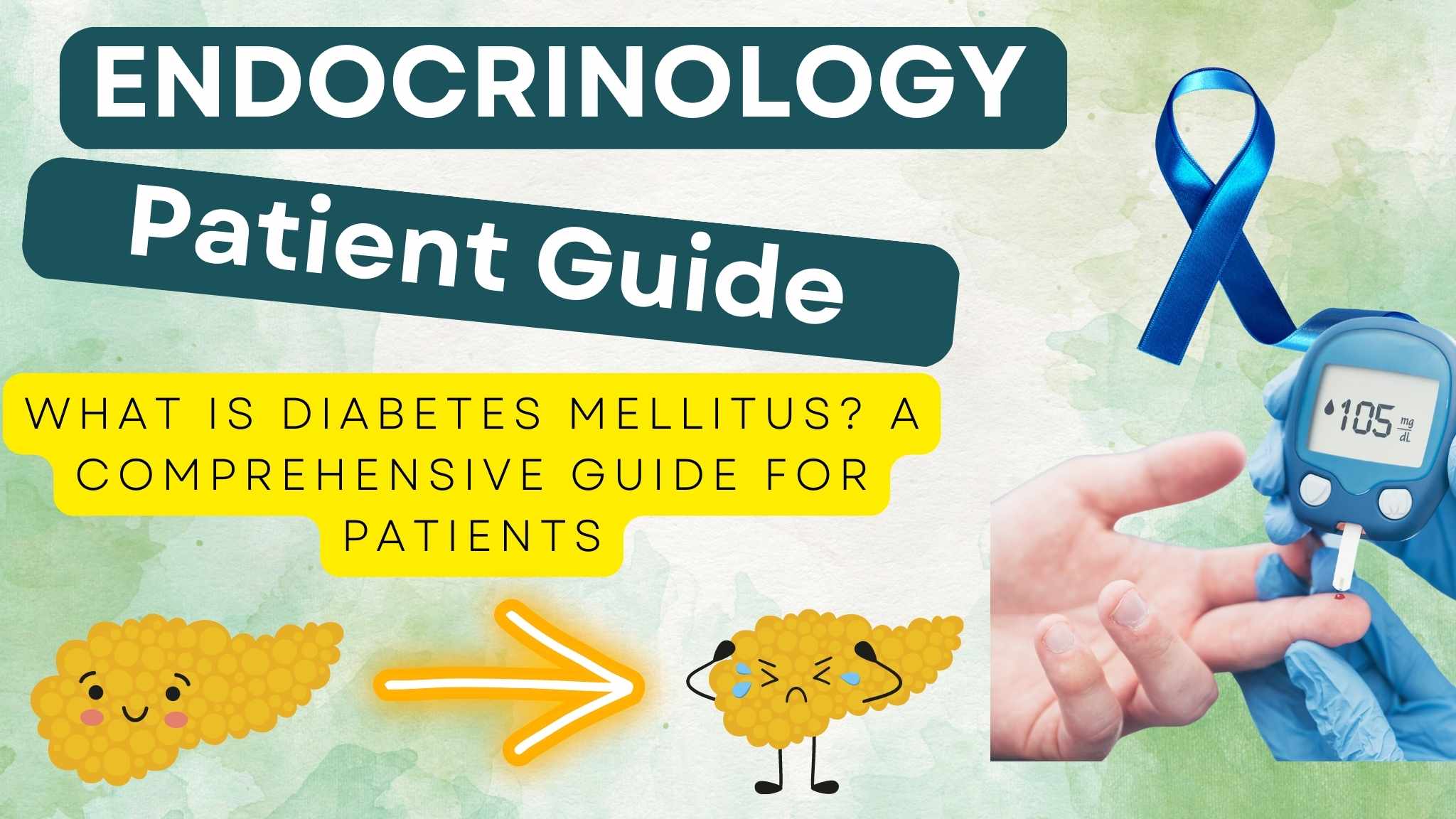
Diabetes mellitus is a chronic condition that affects millions of people worldwide. It occurs when the body fails to produce enough insulin or use it effectively, resulting in high blood sugar levels. Diabetes can lead to numerous health complications if left untreated and unmanaged.
In this blog post, we will explore what diabetes mellitus is, its types and symptoms, associated risks factors as well as diagnosis and treatment options for managing the disease.
We’ll also discuss preventive strategies that medical professionals should consider for patients at risk of developing diabetes mellitus.

What is Diabetes Mellitus?
Diabetes mellitus (DM) is a chronic metabolic disorder characterized by high levels of glucose in the blood. It is caused by either an absolute deficiency of insulin or an inability of the body to use insulin effectively.
Insulin, a hormone produced by the pancreas, helps regulate glucose levels in the bloodstream and provides energy for cells throughout our bodies. Without it, sugar builds up in our blood instead of being used as fuel for metabolism.
Types of Diabetes Mellitus: There are three main types of diabetes mellitus; type 1 diabetes, type 2 diabetes and gestational diabetes. Additional forms of diabetes such as cystic fibrosis-related Diabetes, post-transplant Diabetes, steroid-induced diabetes, maturity-onset diabetes of the young, and latent autoimmune Diabetes of adulthood will not be discussed in this post.
Type 1 DM is an autoimmune condition where the body’s immune system attacks and destroys its pancreatic beta cells that produce insulin, leading to an absolute lack of insulin production.
Type 2 DM on the other hand results from a resistance to insulin action resulting from lifestyle factors such as poor diet and physical activity habits. This leads to inadequate control over blood sugar levels due to insufficient amounts or ineffective utilization of available insulin within our bodies.
Gestational diabetes occurs during pregnancy when hormones secreted by placenta interfere with the normal functioning of the mother’s insulin causing her body not able to produce enough amount or utilize existing amount efficiently. This eventually leads to a higher than normal glucose concentration in her bloodstream during the gestation period. Quite characteristically, most mothers with gestational diabetes experience a complete normalization of their blood glucose after delivery of the baby. Nonetheless, their future risk for type 2 diabetes mellitus remains significantly high than pregnant women without gestational diabetes.
Symptoms of Diabetes Mellitus: Common symptoms associated with all types of Diabetes mellitus include frequent urination, excessive thirst, extreme hunger, weight loss despite increased appetite, and fatigue. This occurs as a result of difficulty in converting food into energy because there isn’t enough circulating insulin present for efficient metabolism of not only carbohydrates, but protein and fats as well.
Other common signs may also include blurry vision, slow-healing wounds , recurrent infections, dry mouth etc.
Complications Associated With Diabetes Mellitus : If left untreated then it can lead various complications like heart disease, stroke, kidney failure, blindness, nerve damage, foot ulcers, gum infection and erectile dysfunction to mention a few. These conditions can be prevented through proper management, including regular monitoring, significant lifestyle changes (such as healthy eating and exercise routine) and adherence with intake of medications prescribed by a physician.
Diagnosis usually involves measuring fasting plasma glucose level, a random blood glucose level (for those with symptoms of hyperglycemia) or glycated hemoglobin.
Treatment
Treatment options mainly depend upon the type and severity of the disease but generally involve a combination of lifestyle modifications, dietary changes, medications (mainly oral medications), injections ( insulin or non-insulin injectable drugs), or insulin pumps.
Key Message
Diabetes Mellitus is a chronic metabolic disorder caused by either an absolute deficiency of insulin or an inability to use insulin effectively. Symptoms include frequent urination, excessive thirst, extreme hunger, and fatigue. Complications can be prevented through proper management, including healthy eating, exercise, and medications prescribed by a physician.
Symptoms of Diabetes Mellitus
It can cause serious health complications if left untreated, so it is important to be aware of the symptoms and seek medical attention as soon as possible.
Frequent Urination: One of the most common signs of diabetes mellitus is frequent urination. This occurs because excess sugar in the blood causes an increase in urine production, which leads to more frequent trips to the bathroom.
Excessive Thirst: Another symptom associated with diabetes mellitus is excessive thirst. People with this condition often feel thirsty even after drinking large amounts of fluids due to dehydration caused by increased urination.
Fatigue: Fatigue and weakness are also common symptoms of diabetes mellitus, especially when combined with other signs such as frequent urination and excessive thirst. This occurs because glucose cannot enter cells without insulin, leading to decreased energy levels throughout the body.
Blurred Vision: Blurred vision can occur due to high levels of glucose in the blood damaging small vessels around your eyes over time, resulting in impaired vision or blindness if left untreated for too long.
Slow Healing Wounds: Diabetes mellitus can also affect wound healing since high blood sugar levels reduce circulation and slow down tissue repair processes throughout your body including skin wounds from cuts or scrapes that take longer than usual to heal properly..
Weight Loss: Unexplained weight loss may be another sign that something isn’t right; people with diabetes tend to lose weight quickly despite eating normally due to their bodies not being able to process food efficiently into energy without enough insulin present in their system.

Complications Associated with Diabetes Mellitus
Insulin is necessary for the body to convert glucose into energy. When this process does not work properly, blood sugar levels can become too high, leading to serious health complications. Long-term complications associated with diabetes mellitus include heart disease, stroke, kidney failure, nerve damage, and eye problems.
Heart Disease: People with diabetes are more likely to develop coronary artery disease than those without it due to the increased risk of atherosclerosis (hardening of arteries). This increases their chances of having a heart attack or stroke twofold compared to people without diabetes.
Stroke: Diabetes also increases the risk of stroke as it causes the narrowing and hardening of arteries in the brain, which reduces blood flow and oxygen supply, causing a stroke.
Kidney Failure: High blood sugar levels over time can cause damage to small vessels in kidneys leading them to be unable to filter waste from your bloodstream resulting in kidney failure requiring dialysis or transplantation if left untreated/poorly treated for long periods of time.
Nerve Damage: Nerve damage caused by uncontrolled high blood sugar levels leads to pain, numbness, and tingling sensation, known as diabetic neuropathy affecting feet and hands.
Eye Problems: Diabetic retinopathy occurs when high blood sugars damages tiny vessels inside eyes causing vision loss or blindness. Other common eye problems related to diabetes include cataracts, glaucoma etc.
Risk factors associated with developing type 2 diabetes include obesity, physical inactivity, family history, and age above 45. Diagnosis involves a fasting plasma glucose test measuring levels higher than 126 mg/dl twice after an 8-hour fast, a glycated hemoglobin A1C greater than or equal to 6.5%. Treatment involves lifestyle modifications such as a healthy diet plan along with a regular exercise routine combined with medications to help control elevated blood sugars and reduce the risk of developing any long-term complications mentioned above.
Complications associated with diabetes mellitus can be serious and even life-threatening, but with proper management of the condition, these risks can be minimized. Now let’s look at some of the risk factors for developing diabetes mellitus.
Key Message
Diabetes mellitus is a chronic metabolic disorder that can lead to serious health complications such as heart disease, stroke, kidney failure, nerve damage and eye problems. Risk factors include obesity, physical inactivity, family history and age above 45 years old. Treatment involves lifestyle modifications combined with medications like metformin to help control elevated blood sugars.
Risk Factors for Developing Diabetes Mellitus
Obesity: Obesity is one of the most common and significant risk factors for developing type 2 diabetes mellitus. People who are overweight or obese tend to have higher levels of fat stored around their abdomen which increases their chances of developing type 2 diabetes compared to those with normal weight ranges. Additionally, obesity can also lead to other conditions such as fatty liver disease and dyslipidemia (high blood cholesterol), which further increase the risk for this disease.
Family History: Having a family history of diabetes increases an individual’s chance of developing this condition significantly compared to those without any family history. This is because genetics play an essential role in determining whether someone will develop type 2 diabetes or not; if one parent has it then their children may be at greater risk, too due to shared genetic traits passed down from generation to generation.
Age Over 45 Years Old: Age is an important factor in increasing the likelihood of developing type 2 diabetes, as older individuals tend to be less active and more prone to gaining weight than younger ones.
Physical inactivity is associated with weight gain and thus an increased risk for diabetes mellitus.
Certain ethnicities are also known to carry a higher probability of getting affected by this disorder, including African Americans, Native Americans, Hispanics/Latinos, and Pacific islanders, among others. Research suggests that environmental influences such as diet habits could explain why certain populations experience increased rates when compared with non-Hispanic whites living within similar socioeconomic backgrounds.
It is important to be aware of the risk factors associated with diabetes mellitus in order to reduce your chances of developing it. Now, let’s take a look at how this condition can be diagnosed and treated.

Diagnosis and Treatment Options for Diabetes Mellitus
Diagnosis of Diabetes mellitus is made through a combination of medical history review and laboratory tests. The most common test used to diagnose diabetes is the fasting plasma glucose test, which measures the amount of glucose in your blood after an overnight fast (8-hour fast). A result higher than 126 mg/dL on two separate occasions indicates that you have diabetes. Other tests, such as oral glucose tolerance tests or glycated hemoglobin A1c may also be used to confirm the diagnosis.
Treatment options for type 2 diabetes mellitus include lifestyle modifications such as diet and exercise, as well as medications like metformin, GLP-1 agonists, sulfonylureas, pioglitazone, SGLT-2 inhibitors or insulin therapy.
Diet should consist of whole grains, fruits, vegetables, lean proteins, and healthy fats while limiting processed foods and added sugars. Exercise should be done regularly for at least 30 minutes per day to help maintain proper weight control and improve overall health. Medications like metformin can help lower blood sugar levels by increasing insulin sensitivity in cells throughout the body, while insulin therapy can provide direct delivery of insulin into the bloodstream when needed to regulate blood sugar levels more effectively.
Type 1 diabetes is managed solely with insulin since this often autoimmune disease is characterized by a complete or near absence of insulin. Patients with this condition do not develop diabetes due to poor dietary choices or a lack of insulin. They actually need insulin to survive and can develop a severe life-threatening medical condition known as diabetic ketoacidosis within a few hours of not having any insulin in their body. An additional hormone known as amylin (also produced by the pancreas) can be used in type 1 diabetes patients to reduce glucose excursions after a meal.
It is important for those with diabetes mellitus to work closely with their healthcare provider in order to develop an individualized treatment plan that works best for them based on their specific needs and goals. With proper management, it is possible to keep blood sugar levels within a normal range and reduce the risk factors associated with long-term complications from this condition, such as heart disease or stroke.
Diagnosis and treatment of diabetes mellitus are essential for successful management. However, prevention strategies are also important in order to reduce the risk of developing this condition (which applies mainly to type 2 diabetes).
Prevention Strategies for Type 2 Diabetes Mellitus
Maintaining a healthy weight is one of the most important prevention strategies for type 2 diabetes mellitus. Regular physical activity and eating a balanced diet low in sugar and saturated fat can help keep your body weight within normal range, reducing your risk of developing this condition. Eating plenty of fruits, vegetables, whole grains, lean proteins, and healthy fats such as nuts and seeds can also help to prevent diabetes mellitus.
Limiting or avoiding processed foods high in added sugars is also an important part of preventing diabetes mellitus. Added sugars are often found in sodas, candy bars, cookies and other sweet treats that should be avoided or limited when trying to maintain a healthy weight. Instead opt for natural sources of sweetness like fresh fruit or honey which contain beneficial nutrients along with their natural sugars.
Smoking has been linked to an increased risk for developing type 2 diabetes mellitus so it’s best to avoid smoking altogether if possible. Additionally drinking alcohol should be done in moderation since heavy alcohol consumption has been associated with an increased risk for developing this condition as well.
Finally, getting regular check-ups from your doctor is essential when it comes to preventing diabetes mellitus. They will be able to monitor your blood glucose levels on a regular basis as well as any changes that may occur over time due to lifestyle factors such as diet or exercise habits which could increase the risk for this condition. Your doctor may also recommend lifestyle modifications such as increasing physical activity or changing dietary habits if necessary in order to reduce the chances of developing type 2 diabetes mellitus later on down the road.
Key Message
Maintaining a healthy weight through physical activity, balanced diet and limiting processed foods can help prevent diabetes mellitus. Avoid smoking and drinking alcohol in moderation, and get regular check-ups from your doctor.
FAQs in Relation to What is Diabetes Mellitus
What do you mean by diabetic Mellitus?
Diabetes mellitus is a chronic metabolic disorder in which the body does not produce enough insulin or does not properly use the insulin it produces. This leads to high levels of glucose (sugar) in the blood, which can cause damage to organs and tissues over time. It is one of the most common endocrine disorders and affects millions of people worldwide. Treatment typically involves lifestyle changes such as diet modification, exercise, and medication management to help control blood sugar levels. Long-term complications may include heart disease, stroke, kidney failure, nerve damage, eye problems, and other health issues if left untreated.
Difference between type 1 and type 2 diabetes mellitus
Type 2 diabetes mellitus is the most common form of diabetes. It occurs when the body does not produce enough insulin or does not use it effectively, resulting in high blood sugar levels. Type 1 diabetes mellitus is an autoimmune disorder that results in the destruction of beta cells in the pancreas, which is responsible for producing insulin. This leads to a lack of insulin production and an inability to regulate blood sugar levels properly.
What causes diabetes mellitus?
Diabetes mellitus is a chronic condition caused by the body’s inability to produce or respond to insulin. Insulin is a hormone produced in the pancreas that helps regulate blood sugar levels. When this process does not work properly, glucose builds up in the bloodstream instead of being used for energy, leading to high blood sugar levels and diabetes.
Can you prevent type 1 diabetes mellitus?
Based on antibody tests, doctors are now able to identify people at risk for diabetes mellitus in the general population. Indeed, there is a new medication that can slow the progression to full blown type 1 diabetes mellitus in patients with positive antibodies for type 1 DM. Teplizumab was approved on November 17, 2022, by the US FDA as a first-in-class therapy for the prevention of stage 3 type 1 diabetes mellitus in both children and adults.
In a landmark study of teplizumab in patients at risk for type 1 diabetes mellitus, a two-week course of the novel drug, teplizumab delayed the onset of type 1 diabetes mellitus by two years and halved the rate of diabetes diagnoses.
Conclusion
In conclusion, diabetes mellitus is a serious medical condition that can have devastating effects on the body if left untreated. It is important to be aware of the risk factors for developing diabetes mellitus and take steps to reduce those risks. Early diagnosis and treatment are essential in order to prevent or delay complications associated with this disease. With proper management, people living with diabetes mellitus can lead healthy lives.
The opinions expressed here represent the views of a practicing hormone specialist (endocrinologist) and must not substitute the advice of your health care provider. This blog post is written for a non-medical audience interested in learning more about hormonal disorders. The author has no commercial conflicts of interest to declare. Also, read our privacy policy.
Kindly Let Us Know If This Was helpful? Thank You!


